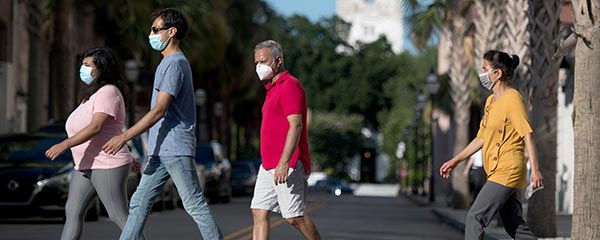Story Highlights
- 27% of U.S. workers worry about being laid off, up from 15% in 2019
- 27% worry about having their work hours cut, up from 15% last year
- Non-White workers are substantially more worried than White workers
WASHINGTON, D.C. -- As the U.S. continues to reel from the economic impact of the COVID-19 pandemic, with unprecedented closure of businesses and public health restrictions to stem the spread of the disease, American workers' worries about setbacks to their employment have spiked. More than a quarter, 27% of U.S. workers now say they are worried they will be laid off from their jobs, up from 15% a year ago.
Twenty-seven percent of U.S. workers now fear their hours will be cut back, up from 15% in 2019, while 28% fear their wages will be reduced, up from 16% last year. Workers' worries their benefits will be reduced are also up, though less so than other worries, with 30% worried this will occur, up from 23% in 2019. Nearly half of U.S. workers, 46%, are worried about one or more of the four setbacks at their jobs.
| 2019 | 2020 | Change | |||||||||||||||||||||||||||||||||||||||||||||||||||||||||||||||||||||||||||||||||||||||||||||||||
|---|---|---|---|---|---|---|---|---|---|---|---|---|---|---|---|---|---|---|---|---|---|---|---|---|---|---|---|---|---|---|---|---|---|---|---|---|---|---|---|---|---|---|---|---|---|---|---|---|---|---|---|---|---|---|---|---|---|---|---|---|---|---|---|---|---|---|---|---|---|---|---|---|---|---|---|---|---|---|---|---|---|---|---|---|---|---|---|---|---|---|---|---|---|---|---|---|---|---|---|
| % | % | pct. pts. | |||||||||||||||||||||||||||||||||||||||||||||||||||||||||||||||||||||||||||||||||||||||||||||||||
| That you will be laid off | 15 | 27 | 12 | ||||||||||||||||||||||||||||||||||||||||||||||||||||||||||||||||||||||||||||||||||||||||||||||||
| That your hours at work will be cut back | 15 | 27 | 12 | ||||||||||||||||||||||||||||||||||||||||||||||||||||||||||||||||||||||||||||||||||||||||||||||||
| That your wages will be reduced | 16 | 28 | 12 | ||||||||||||||||||||||||||||||||||||||||||||||||||||||||||||||||||||||||||||||||||||||||||||||||
| That your benefits will be reduced | 23 | 30 | 7 | ||||||||||||||||||||||||||||||||||||||||||||||||||||||||||||||||||||||||||||||||||||||||||||||||
| Gallup | |||||||||||||||||||||||||||||||||||||||||||||||||||||||||||||||||||||||||||||||||||||||||||||||||||
| * Among Americans employed full or part time. | |||||||||||||||||||||||||||||||||||||||||||||||||||||||||||||||||||||||||||||||||||||||||||||||||||
These data come from Gallup's annual Work and Education survey, conducted July 30-Aug. 12. The survey was conducted following a drop in the U.S. employment rate in July, to 10.2% While this is still more than twice as high as the 3.7% unemployment rate for July 2019, it is down from the 14.7% rate recorded in April of this year, as the initial lockdown to control the spread of COVID-19 threw the U.S. economy into a tailspin.
Worker Worries at Highest Points in Years
Not surprisingly, given the disruption to the economy, U.S. workers' worries about negative events at their jobs are the highest they have been in years. The 27% of American workers who are worried about being laid off from their current jobs is the highest level since the 29% seen in August 2013, at the tail end of the Great Recession and ensuing periods of high unemployment.

Line graph. American workers fears of being laid off from their jobs. 27% of American workers now fear being laid off up from 15% in 2019.
Worries about wages being cut have followed a similar pattern, with the current 28% of workers worried about this being the highest level since 31% recorded in August 2013. Worker concern about having their hours cut is at its highest point since 2011, when 30% were worried.
Only workers' worries of having their benefits cuts have displayed a different pattern, with worry about this registering 30% or above for most of Gallup's trend since 1997. The only year workers' worry about benefit cuts was significantly below 30% was 2019 (23%).
Non-White Workers Substantially More Worried Than White Workers
Worry about the four potential setbacks is up among all subgroups. However, White workers remain less worried about these setbacks than non-White workers. The largest gap, 23 percentage points, is on worry that wages will be reduced, 20% for White workers, vs. 43% for non-White workers. This is followed closely by a 21-point gap on worry they will be laid off -- 20% for White workers, 41% for non-White workers. Additionally, there is a 19-point gap in worry about benefits being cut and a 14-point gap on worry about having work hours cut back.
| That you will be laid off | That your hours at work will be cut back |
That your wages will be reduced |
That your benefits will be reduced |
||||||||||||||||||||||||||||||||||||||||||||||||||||||||||||||||||||||||||||||||||||||||||||||||
|---|---|---|---|---|---|---|---|---|---|---|---|---|---|---|---|---|---|---|---|---|---|---|---|---|---|---|---|---|---|---|---|---|---|---|---|---|---|---|---|---|---|---|---|---|---|---|---|---|---|---|---|---|---|---|---|---|---|---|---|---|---|---|---|---|---|---|---|---|---|---|---|---|---|---|---|---|---|---|---|---|---|---|---|---|---|---|---|---|---|---|---|---|---|---|---|---|---|---|---|
| % | % | % | % | ||||||||||||||||||||||||||||||||||||||||||||||||||||||||||||||||||||||||||||||||||||||||||||||||
| All U.S. Workers | 27 | 27 | 28 | 30 | |||||||||||||||||||||||||||||||||||||||||||||||||||||||||||||||||||||||||||||||||||||||||||||||
| Male | 27 | 26 | 28 | 32 | |||||||||||||||||||||||||||||||||||||||||||||||||||||||||||||||||||||||||||||||||||||||||||||||
| Female | 27 | 29 | 29 | 27 | |||||||||||||||||||||||||||||||||||||||||||||||||||||||||||||||||||||||||||||||||||||||||||||||
| White workers | 20 | 23 | 20 | 23 | |||||||||||||||||||||||||||||||||||||||||||||||||||||||||||||||||||||||||||||||||||||||||||||||
| Non-white workers | 41 | 37 | 43 | 42 | |||||||||||||||||||||||||||||||||||||||||||||||||||||||||||||||||||||||||||||||||||||||||||||||
| 18-34 | 20 | 26 | 24 | 23 | |||||||||||||||||||||||||||||||||||||||||||||||||||||||||||||||||||||||||||||||||||||||||||||||
| 35-54 | 34 | 30 | 33 | 33 | |||||||||||||||||||||||||||||||||||||||||||||||||||||||||||||||||||||||||||||||||||||||||||||||
| 55+ | 24 | 25 | 24 | 31 | |||||||||||||||||||||||||||||||||||||||||||||||||||||||||||||||||||||||||||||||||||||||||||||||
| College graduate | 22 | 20 | 30 | 32 | |||||||||||||||||||||||||||||||||||||||||||||||||||||||||||||||||||||||||||||||||||||||||||||||
| College nongraduate | 30 | 32 | 27 | 28 | |||||||||||||||||||||||||||||||||||||||||||||||||||||||||||||||||||||||||||||||||||||||||||||||
| *Among Americans employed full or part time. | |||||||||||||||||||||||||||||||||||||||||||||||||||||||||||||||||||||||||||||||||||||||||||||||||||
| Gallup | |||||||||||||||||||||||||||||||||||||||||||||||||||||||||||||||||||||||||||||||||||||||||||||||||||
Prior to the COVID-19 pandemic, non-White workers were substantially more likely to worry about being laid off, and having their hours or wages cut, than White workers. The likelihood of worry about being laid off has increased at roughly similar levels for both non-White and White workers since the pandemic began, 13 points vs. 10 points. However, compared with 2019, White workers are now 17 points more likely to be worried about having their hours cut, while non-White workers are seven points more likely. Additionally, White workers are now 14 points more likely to be worried about having their wages reduced than they were in 2019, compared with a 9-point increase in worry about among non-White workers.
| That your benefits will be reduced | |||||||||||||||||||||||||||||||||||||||||||||||||||||||||||||||||||||||||||||||||||||||||||||||||||
|---|---|---|---|---|---|---|---|---|---|---|---|---|---|---|---|---|---|---|---|---|---|---|---|---|---|---|---|---|---|---|---|---|---|---|---|---|---|---|---|---|---|---|---|---|---|---|---|---|---|---|---|---|---|---|---|---|---|---|---|---|---|---|---|---|---|---|---|---|---|---|---|---|---|---|---|---|---|---|---|---|---|---|---|---|---|---|---|---|---|---|---|---|---|---|---|---|---|---|---|
| % | % | ||||||||||||||||||||||||||||||||||||||||||||||||||||||||||||||||||||||||||||||||||||||||||||||||||
| 2019 | 2020 | ||||||||||||||||||||||||||||||||||||||||||||||||||||||||||||||||||||||||||||||||||||||||||||||||||
| All U.S. Workers | 23 | 30 | |||||||||||||||||||||||||||||||||||||||||||||||||||||||||||||||||||||||||||||||||||||||||||||||||
| Male | 23 | 32 | |||||||||||||||||||||||||||||||||||||||||||||||||||||||||||||||||||||||||||||||||||||||||||||||||
| Female | 23 | 27 | |||||||||||||||||||||||||||||||||||||||||||||||||||||||||||||||||||||||||||||||||||||||||||||||||
| White | 14 | 23 | |||||||||||||||||||||||||||||||||||||||||||||||||||||||||||||||||||||||||||||||||||||||||||||||||
| Non-white | 39 | 42 | |||||||||||||||||||||||||||||||||||||||||||||||||||||||||||||||||||||||||||||||||||||||||||||||||
| College Grad | 19 | 32 | |||||||||||||||||||||||||||||||||||||||||||||||||||||||||||||||||||||||||||||||||||||||||||||||||
| Non-College grad | 25 | 28 | |||||||||||||||||||||||||||||||||||||||||||||||||||||||||||||||||||||||||||||||||||||||||||||||||
| *Among Americans employed full or part time. | |||||||||||||||||||||||||||||||||||||||||||||||||||||||||||||||||||||||||||||||||||||||||||||||||||
| Gallup | |||||||||||||||||||||||||||||||||||||||||||||||||||||||||||||||||||||||||||||||||||||||||||||||||||
Finally, when it comes to fear of having benefits cut, White workers are nine points more likely to worry about this now than in 2019, compared with a three-point increase among non-white workers. There have been substantial gaps in worry between White workers and non-White workers for all four work setbacks for most of Gallup's trend, with non-White workers typically more worried than their White counterparts.
Bottom Line
The COVID-19 epidemic and associated public health measures to control the spread of the disease has had a devastating impact on the U.S. economy. The resulting spike in American workers' worries about negative events at their work is not surprising, but the magnitude of the change is partly because worker worries were at the low end of Gallup's trend in 2019.
Worry about being laid off and having hours, wages or benefits cut was substantially more likely among non-White workers than White workers even prior to the pandemic. And, while the likelihood of worry on several issues has had risen by higher amounts among White workers, non-White workers remain the group substantially more likely to be worried.
View complete question responses and trends (PDF download).
Learn more about how the works.




